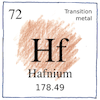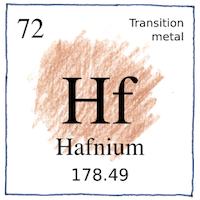Copenhagen—Dirk Coster,
Georg von Hevesy
elements

|
Hafnium
Dmitri Mendeleev predicted a heavier analog of titanium and zirconium. Henry Moseley predicted an element between 71 and 73. Georg Urbain said he found it and named it celtium, but his work didn’t satisfy either chemists or physicists. Vladimir Ivanovich Vernadskij and Konstantin Avtonomovich Nenadkevich probably found it but wars intervened before they published their report. Niels Bohr, Charles R. Bury, and others said it should resemble zirconium. So Dirk Coster and Georg von Hevesy in Copenhagen found it in zirconium ores from Norway using X-ray spectroscopic analysis and named it after the Latin for Copenhagen.
Atomic number 72
Most hafnium is used in control rods for nuclear power plants. Small amounts are used as gate insulators in integrated circuits, as oxygen and nitrogen scavengers in fluorescent and incandescent lamps, and to strengthen protective oxide layers of nickel-based alloys.
Very bad science
Very bad science shows hafnium-178m2 is more dangerous than TNT. It shows hafnium could be used to trigger nuclear bombs. It shows that hafnium can increase the expense of plasma cutting tools for the garage mechanic, and provide cathode-ray guns for the masses that exceed the destructive potential of automobiles and the second amendment combined.



Rhenium and hafnium were the last two stable elements to be discovered. It might be that we have not yet invented the best uses for these exotic elements.
See also in The book of science:
Readings in wikipedia:
Other readings: